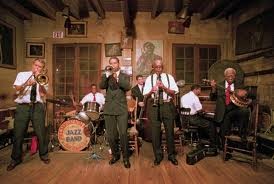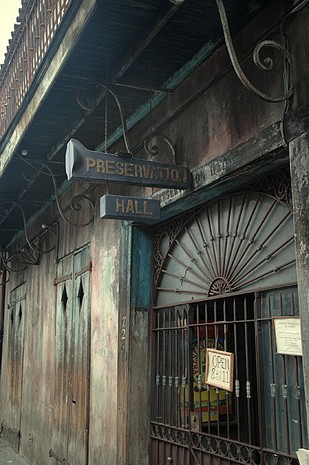Preservation Hall
Introduction
Text-to-speech Audio
Founded in 1961, Preservation Hall is a musical venue in the French Quarter to protect, preserve, and perpetuate traditional New Orleans jazz. The Preservation Hall venue presents intimate, acoustic New Orleans jazz concerts over 350 nights a year featuring ensembles from a current collective of 100+ local master practitioners. On any given night, audiences bear joyful witness to the evolution of this venerable and living tradition. It is also a record label recording studio and a non-profit foundation.
Images
Jazz band performs at Preservation Hall

Front entrance to Preservation Hall. Looks can be deceiving.

Backstory and Context
Text-to-speech Audio
The story of Preservation Hall dates back to the 1950s at Associated Artists, a small art gallery at 726 St. Peter Street in New Orleans’s French Quarter. Upon opening the gallery, the proprietor, art dealer Larry Borenstein, found that it curtailed his ability to attend the few remaining local jazz concerts. He began inviting these musicians to perform “rehearsal sessions” in the gallery itself. Soon over time, the music was becoming more attractive than the art on display. These concerts featured living legends of New Orleans Jazz like George Lewis, Punch Miller, Sweet Emma Barrett, Billie and De De Pierce, The Humphrey Brothers, and dozens more.
During this period, traditional jazz had taken a backseat in popularity to the genres of rock n’ roll and bebop which left many of these players to work odd jobs to make their financial gains. Although concerted efforts by aficionados, such as William “Bill” Russell, succeeded in recording and documenting this fading artform during the “New Orleans Jazz Revival” of the 1940s, venues that offered live New Orleans jazz were few and far between. Before long, Borenstein’s sessions took on a life of their own and enthusiasts of the music gravitated toward the gallery, including a young couple from Pennsylvania named Allan and Sandra Jaffe. The Jaffes arrived in New Orleans in 1960 on an extended honeymoon from Mexico City. During their visit, they conversed with a few jazz musicians in Jackson Square, who were on their way to “Mr. Larry’s Gallery.” As avid fans of New Orleans jazz, the honeymooners followed the musicians and were introduced to Borenstein along with a number of living jazz legends that had gathered that evening for a jam session. Needless to say, they were enraptured by what they saw and heard. The music was pure and unaffected by the swaying of popular music. The Jaffes knew they happened upon something special and moved to New Orleans permanently after their honeymoon.
The jam sessions at the gallery became much more frequent and that prompted Borenstein to move his gallery to the building next door to make way for a place where jazz music could thrive. Performances were held nightly for donations and were organized by a short-lived, non-profit organization named The New Orleans Society for The Preservation of Traditional Jazz. Shortly after, The Jaffes returned to New Orleans and Borenstein passed the nightly operations of the hall to Allan Jaffe on a profit-and-loss basis. This was where Preservation Hall was born. A new chapter for the Jazz genre was beginning.
The nightly jazz concerts at Preservation Hall gathered a significant amount of press interest from its inception. The news attention started with local television news around New Orleans and quickly went to the mainstream media along with online newsletters. As time went on, Allan believed the success of both the Hall and it’s mission of preservation would require these bands to tour the world so in 1963, he organized the newly minted Preservation Hall Jazz Band for a string of performances in the Midwest. True to Jaffe’s estimation, the tour was a resounding success and interest in the band lead the rediscovery of New Orleans jazz to as far as Japan. The following decades found the band traveling and featured on a wide array of television performances. Following Allan Jaffe’s untimely passing in 1987, Preservation Hall and The Preservation Hall Jazz Band now operate under the leadership of the Jaffe’s second son, Benjamin.
Picking up the mission where his parents left off, Benjamin Jaffe began a series of initiatives centered around expanding listenership to the music both at the Hall and on tour. As the years continued, the band began and welcomed a number of collaborative tours and recordings with artists outside of the traditional Jazz genre, including the Blind Boys of Alabama (gospel), Mos Def (hip-hop), the Del McCoury Band (bluegrass), My Morning Jacket (rock), and even a modern dance/ballet collaboration with critically-acclaimed choreographer Trey McIntyre. In addition to rejuvenating the music, Preservation Hall engages with the New Orleans cultural community emphasizing education and social programming. Persevering through the hardships of Hurricane Katrina and the BP oil spill, the Preservation Hall team created and supported organizations, such as The Preservation Hall Music Outreach Program, The New Orleans Jazz & Heritage Foundation, and the Make It Right Foundation.
Sources
Sancton, Tom. “Hall That Jazz,” Vanity Fair. Accessed February 02, 2017. http://www.vanityfair.com/culture/2012/01/preservation-hall-201201.
“Our Story,” Preservation Hall website. Accessed July 30th 2021. https://www.preservationhall.com/about/
